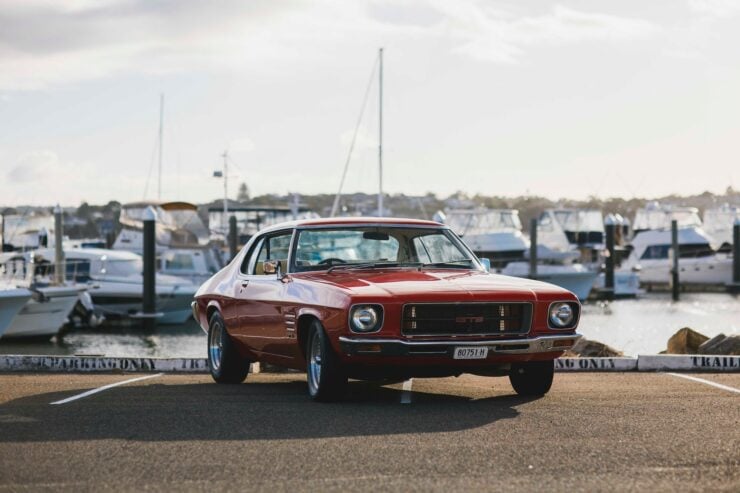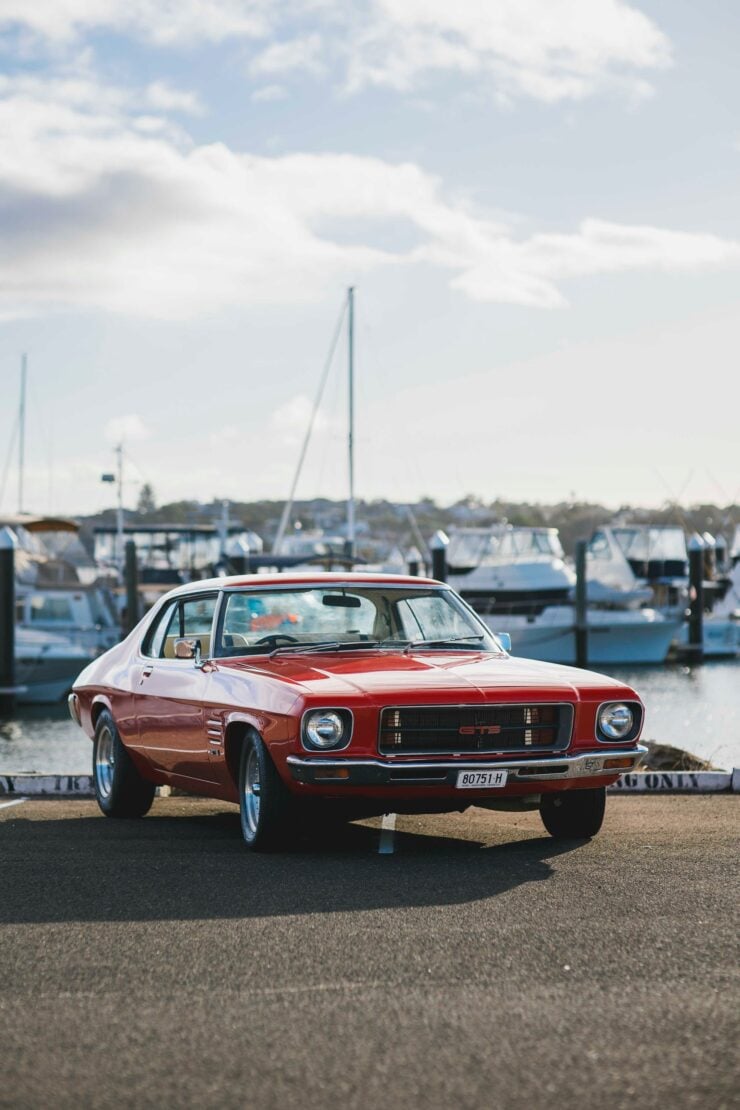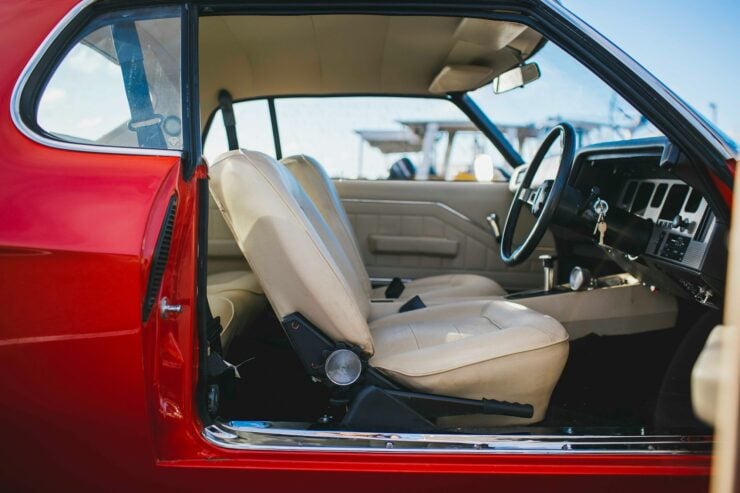This is a 1972 Holden HQ GTS Monaro, and if you’re not from the southern hemisphere you may never have encountered one before – it’s a 100% Australian-developed car.
The Monaro family of sports cars debuted in 1968 with the first generation model, the HK Monaro. The series would be produced over three major generations, and today they’re among the most highly-prized Australian cars of all time.
Fast Facts – The Holden HQ GTS Monaro
- The HQ series of the Monaro began development in April 1968, with design leadership transitioning from John Schinella to Leo Pruneau in June 1969. The design, finalized in mid-1969 for a July 1971 release, showcased a blend of American and homegrown Australian styling influences, marked by a forward-reaching front and flowing rear lines.
- The HQ version of the Monaro GTS eliminated all six-cylinder engine options, offering a 4.15 liter or a 5.0 liter V8, both locally manufactured, or a 5.7 liter Chevrolet V8 for the top-level GTS 350.
- The HQ was seen as one of the definitive Australian car of its time and it remains a highly collectible classic today with prices seeming to reach ever skyward.
- The car you see here is a 1972 Monaro HQ finished in bright red, with a cream leather-trimmed interior riding on period-correct aftermarket 15 inch Center Line alloy wheels. It’s now being offered for sale out of San Souci, Australia on the Collecting Cars platform.
The Origin Of The Name Monaro
The “Monaro” name worked so perfectly alongside Camaro, its General Motors sibling from the USA, that it could have been dreamed up by a particularly fruitful all-hands marketing meeting at Holden. But it wasn’t. The name was stumbled across entirely by accident by a technical stylist and member of Holden’s design team named Noel Bedford when he was on holiday.


It was late 1967 and Holden’s all-new sporting coupe was merely nine months from launch, and it was still without a name. Hundreds of suggestions had been made but none of them had stuck, the closest had been the name “Torana,” and this was used for a number of the upcoming car’s clay models, but as it played out the time for that name hadn’t quite yet come.
Noel Bedford’s holiday had started much like any other, he was on a road trip tour of Australia’s South Eastern region around the Snowy Mountains. It would be here when driving through the town of Cooma, New South Wales, that he noticed a sign on the council offices.
This sign read “Monaro County Council” and it had been professionally painted in a classic “Old West” type font. The name Monaro seemed like a perfect union of Marlboro Country and Camaro, Bedford made a note of it and was later quoted as saying: “It seemed to me so simple and logical. Why didn’t somebody think of it before? I was quite excited and couldn’t wait to get back to work.”
When he did get back to work his colleagues loved the name, it was quickly checked for copyright, and the names etymology was researched. As it happens the name Monaro is of Aboriginal origin, meaning a “high plateau” or “high plain,” a perfect choice then for Holden’s new sports car that they hoped would enjoy high sales figures.
The Holden HQ GTS Monaro
The original Monaro was released in 1968, the Monaro HK. This was the car that set the standard for what the Monaro should be, and it was shortly followed by the HT and HG models.


The second generation Monaro would debut in 1971 with the Monaro HQ. This was an all-new design that was both larger and more luxurious than its forebears, mirroring a similar trend in US muscle car design from the late 1960s and into the 1970s.
The design of the HQ Monaro more closely resembled that of the primary Holden four-door sedan of the time, the Kingswood. This similarity was a deliberate choice by the General Motors-owned Australian car maker, it would both result in significant parts sharing and subsequent cost savings, and it would allow the Monaro to act as a halo car for the more practical sedan.
This philosophy would be taken be step further in 1973 when a version of the HQ Monaro GTS was offered for sale in four-door sedan configuration.
At the time of its release the HQ version of the Monaro was offered with no six-cylinder engine option. Buyers had the choice between the 4.15 liter (253 cubic inch) or 5.0 liter (308 cubic inch) V8s or the engine used in the GTS350 – an imported 5.7 liter (350 cubic inch) Chevrolet V8.
The 4-speed manual transmission came as standard, though you could opt for a 3-speed automatic and many did, as the Monaro was rapidly evolving into a GT car used for longer distance travel rather than a sports car.


The HQ would be succeeded by the HJ, HX, HZ models until it was discounted in 1977. It would remain once of the most loved Australian-built cars for decades after it left production, finally being brought back by Holden in 2001 as the third generation V2 model.
This “new” Monaro would enjoy more success than any of its forebears, it was picked up and sold in the UK as the Vauxhall Monaro and in the United States by Pontiac as the new Pontiac GTO.
The 1972 Holden HQ GTS Monaro Shown Here
The car you see here is a 1972 Holden HQ GTS Monaro that has the Australian-made 308 cubic inch (5.0 liter) V8 under the hood – arguably the most true blue Australian version of the model that was made.
This Monaro is finished in bright red over a cream leather-trimmed interior, and it has a three-spoke sports steering wheel, heating and ventilation, four inertia-reel seatbelts, and chrome kick panels.


It rides on 15 inch Center Line alloy wheels, and it has an aftermarket Alpine stereo head unit, uprated speakers, a Speco centre console-mounted oil temperature gauge, and Koni shock absorbers on all four corners.
It’s now being offered for sale on Collecting Cars out of San Souci, in New South Wales, Australia and you can visit the listing here if you’d like to read more about it or register to bid.















Images courtesy of Collecting Cars








